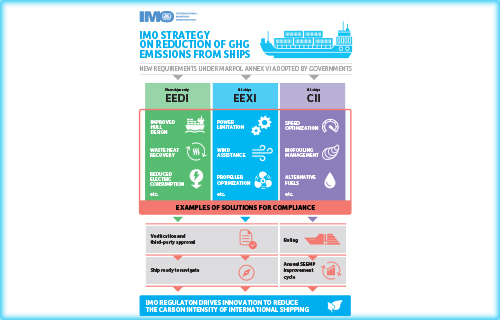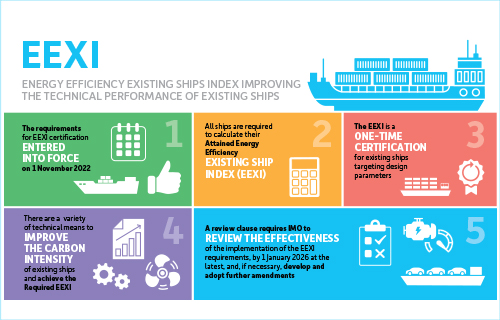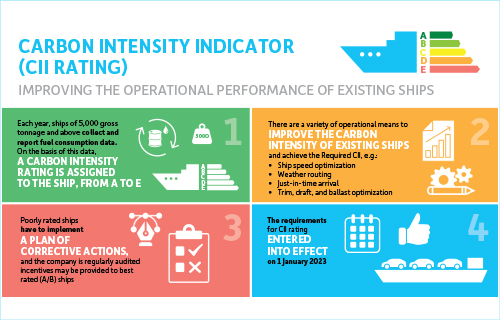EEXI and CII - ship carbon intensity and rating system
Frequently asked questions on the Energy Efficiency Existing Ship Index (EEXI) and the annual operational carbon intensity indicator (CII) and CII rating.

Amendments to the International Convention for the Prevention of Pollution from Ships (MARPOL) Annex VI entered into force on 1 November 2022. Developed under the framework of the Initial IMO Strategy on Reduction of GHG Emissions from Ships agreed in 2018, these technical and operational amendments require ships to improve their energy efficiency in the short term and thereby reduce their greenhouse gas emissions.
From 1 January 2023 it became mandatory for all ships to calculate their attained Energy Efficiency Existing Ship Index (EEXI) to measure their energy efficiency and to initiate the collection of data for the reporting of their annual operational carbon intensity indicator (CII) and CII rating.
IMO Strategy on Reduction of GHG Emissions from Ships
Overview of energy efficiency and carbon intensity requirements
What are the mandatory measures?
As a stimulus to reduce carbon intensity of all ships by 40% by 2030 compared to 2008 baseline, ships are required to calculate two ratings: their attained Energy Efficiency Existing Ship Index (EEXI) to determine their energy efficiency, and their annual operational Carbon Intensity Indicator (CII) and associated CII rating. Carbon intensity links the GHG emissions to the amount of cargo carried over distance travelled.
When did the measures come into force?
The amendments to MARPOL Annex VI entered into force on 1 November 2022. The requirements for EEXI and CII certification came into effect on 1 January 2023. The first annual reporting is to be completed in 2023, with initial ratings given in 2024.
The measures are part of IMO's commitment under its 2018 Initial Strategy on Reduction of GHG Emissions from Ships to reduce carbon intensity from all ships.
The 2023 IMO GHG Strategy calls for carbon intensity of the ship to decline through further improvement of the energy efficiency for new ships - to review with the aim of strengthening the energy efficiency design requirements for ships; and for carbon intensity of international shipping to decline - to reduce CO2 emissions per transport work, as an average across international shipping, by at least 40% by 2030, compared to 2008.
The overall ambition is to reach net-zero GHG emissions by or around, i.e. close to, 2050.
A review of the measures is to be completed by 1 January 2026.
Read more here.
What is an Energy Efficiency Existing Ship Index (EEXI)?
A ship's attained EEXI indicates its energy efficiency compared to a baseline. The attained EEXI will then be compared to a required Energy Efficiency Existing Ship Index based on an applicable reduction factor expressed as a percentage relative to the Energy Efficiency Design Index (EEDI) baseline. It must be calculated for ships of 400 gt and above, in accordance with the different values set for ship types and size categories. The calculated attained EEXI value for each individual ship must be below the required EEXI, to ensure the ship meets a minimum energy efficiency standard.
What is a Carbon Intensity Indicator rating?
The CII determines the annual reduction factor needed to ensure continuous improvement of a ship's operational carbon intensity within a specific rating level. The actual annual operational CII achieved must be documented and verified against the required annual operational CII. This enables the operational carbon intensity rating to be determined.
How do the ratings work?
Based on a ship's CII, its carbon intensity is rated A, B, C, D or E (where A is the best). The rating indicates a major superior, minor superior, moderate, minor inferior, or inferior performance level. The performance level is recorded in a "Statement of Compliance" to be further elaborated in the ship's Ship Energy Efficiency Management Plan (SEEMP).
A ship rated D for three consecutive years, or E for one year, has to submit a corrective action plan to show how the required index of C or above will be achieved.
A ship run on a low-carbon fuel can clearly get a higher rating than one running on fossil fuel, but there are many things a ship can do to improve its rating, through measures such as:
hull cleaning to reduce drag;
speed and routeing optimization;
installation of low energy light bulbs; and
installation of solar/wind auxiliary power for accommodation services.
Incentives
Administrations, port authorities and other stakeholders as appropriate, are encouraged to provide incentives to ships rated as A or B.
How do the measures fit into IMO's decarbonization strategy?
The introduction of mandatory EEXI and CII comes under the framework of the Initial IMO Strategy for Reduction of GHG Emissions from Ships, adopted in 2018. The Initial Strategy set out candidate short- mid- and long-term measures.
When will the measures be reviewed?
IMO's Marine Environment Protection Committee (MEPC) is to review the effectiveness of the implementation of the CII and EEXI requirements by 1 January 2026 at the latest. (See Review Plan of the Short-Term GHG Measure)
The Committee will develop and adopt further amendments as required.
The review paragraph states: Regulation 28
Operational carbon intensity:
Review
11 A review shall be completed by 1 January 2026 by the Organization to assess:
.1 the effectiveness of this regulation in reducing the carbon intensity of international shipping;
.2 the need for reinforced corrective actions or other means of remedy, including possible additional EEXI requirements;
.3 the need for enhancement of the enforcement mechanism;
.4 the need for enhancement of the data collection system; and
.5 the revision of the Z factor and CIIR values.
If based on the review the Parties decide to adopt amendments to this regulation, such
amendments shall be adopted and brought into force in accordance with the provisions of
article 16 of the present Convention.
In adopting the measure, MEPC also considered the outcomes of a comprehensive impact assessment of the measure which examined potential negative impacts on States, and agreed to keep the impacts on States of the measure under review so that any necessary adjustments can be made. MEPC also agreed that disproportionately negative impacts of the measure should be assessed and addressed, as appropriate.
What about support for developing States in particular small island developing States (SIDS) and least developed countries (LDCs)?
IMO has a comprehensive programme of support for developing States to implement IMO regulations. In addition to IMO's Integrated Technical Cooperation Programme (ITCP), the dedicated IMO GHG TC Trust Fund support developing countries with the implementation of the Initial IMO GHG Strategy, there are a number of global projects specifically targeting GHG reduction measures, including: GreenVoyage2050; GHG SMART; NEXTGEN; IMO CARES; the Global MTCC Network; Innovation Forum. Read more: PartnershipsProjects
What about new and alternative fuels for ships?
New fuels will be crucial for decarbonizing the shipping sector. IMO held the Second IMO Symposium on low- and zero-carbon fuels for shipping: "Ensuring a just and inclusive transition towards low-carbon shipping" on 21 October 2022 to look at the challenges and opportunities that renewable fuel production represents in the context of shipping decarbonization, particularly for developing countries, SIDS and LDCs, while also assessing what other elements could constitute a just and equitable transition. Download presentations here: IMO-Symposium-on-alternative-low--and-zero-carbon-fuels-for-shipping-2022.
Where can I download the regulations and guidelines?
Please download the revised MARPOL Annex VI (2021 Revised MARPOL Annex VI) and related guidelines via this page: Index-of-MEPC-Resolutions-and-Guidelines-related-to-MARPOL-Annex-VI
Guidelines
The following comprehensive set of guidelines, adopted by MEPC 76/78, support the new requirements:
Resolution MEPC.350(78) - 2022 Guidelines on the method of calculation of the Attained Energy Efficiency Existing Ship Index (EEXI);
Resolution MEPC.351(78) - 2022 Guidelines on survey and certification of the Attained Energy Efficiency Existing Ship Index (EEXI);
Resolution MEPC.335(76) - 2021 Guidelines on the shaft/engine power limitation system to comply with the EEXI requirements and use of a power reserve;
Resolution MEPC.352(78) - 2022 Guidelines on operational carbon intensity indicators and the calculation methods (CII Guidelines, G1);
Resolution MEPC.353(78) - 2022 Guidelines on the reference lines for use with Operational Carbon Intensity Indicators (CII Reference Lines Guidelines, G2);
Resolution MEPC.338(76) - 2021 Guidelines on the operational carbon intensity reduction factors relative to reference lines (CII Reduction Factor Guidelines, G3);
Resolution MEPC.354(78) - 2022 Guidelines on the operational carbon intensity rating of ships (CII Rating Guidelines, G4);
Resolution MEPC.355(78) - 2022 Interim Guidelines on correction factors and voyage adjustments for CII calculations (CII Guidelines, G5).
Which ships do the CII and EEXI regulations apply to?
In general, MARPOL Annex VI regulations apply to "all ships except where otherwise stated" (MARPOL Annex VI Regulation 1 Application The provisions of this Annex shall apply to all ships, except where expressly provided otherwise.)
The regulations on carbon intensity of international shipping in Chapter 4 of MARPOL Annex VI apply to all ships of 400 gross tonnage and above. Notwithstanding, the provisions of Chapter 4 do not apply to ships solely engaged in voyages within waters subject to the sovereignty or jurisdiction of the State the flag of which the ship is entitled to fly. However, each Party should ensure, by the adoption of appropriate measures, that such ships are constructed and act in a manner consistent with the requirements of chapter 4 of this Annex, so far as is reasonable and practicable. (Regulation 19 Application 1 This chapter shall apply to all ships of 400 gross tonnage and above.)
While EEXI generally applies to each ship of 400 gross tonnage and above, CII applies to ships 5,000 gross tonnage and above. Ships at or above 400 gross tonnage will need to be surveyed and issued with the appropriate certificates.
For survey and certification purposes, MARPOL Annex VI applies to every ship of 400 gross tonnage and above. (MARPOL Annex VI Regulation 5 Surveys 1 Every ship of 400 gross tonnage and above and every fixed and floating drilling rig or other platform shall….be subject to the surveys specified…)
The ships covered include: bulk carrier, gas carrier, tanker, containership, general cargo ship, refrigerated cargo carrier, combination carrier, LNG carrier, Ro-ro cargo ship, ro-ro passenger ship, cruise passenger ship.
EEXI
EEXI applies to: ".1 each ship; and .2 each ship which has undergone a major conversion". (MARPOL Annex VI Regulation 23 Attained Energy Efficiency Existing Ship Index (attained EEXI) 1 The attained EEXI shall be calculated for: .1 each ship; and .2 each ship which has undergone a major conversion.)
CII
CII applies to ships of 5,000 gross tonnage and above (similar to the ships subject to Regulation 27 on mandatory annual fuel consumption reporting to the IMO Ship Fuel Oil Consumption Database).
(MARPOL Annex VI Regulation 28 Operational carbon intensity Attained annual operational carbon intensity indicator (attained annual operational CII) 1 After the end of calendar year 2023 and after the end of each following calendar year, each ship of 5,000 gross tonnage and above…. shall calculate the attained annual operational CII over a 12-month period from 1 January to 31 December for the preceding calendar year.)
How many countries are party to these regulations?
The CII and EEXI regulations are in the Annex VI of the International Convention for the Prevention of Pollution by Ships (MARPOL). Annex VI was adopted through a Protocol adopted in 1997. Amendments since then have been adopted under the "tacit acceptance" process, meaning they come into force on a set date (unless a specified number of Parties object). Currently, as of 1 November 2022, MARPOL Annex VI has 105 Parties, representing between them 96.81% of world merchant shipping by tonnage.



